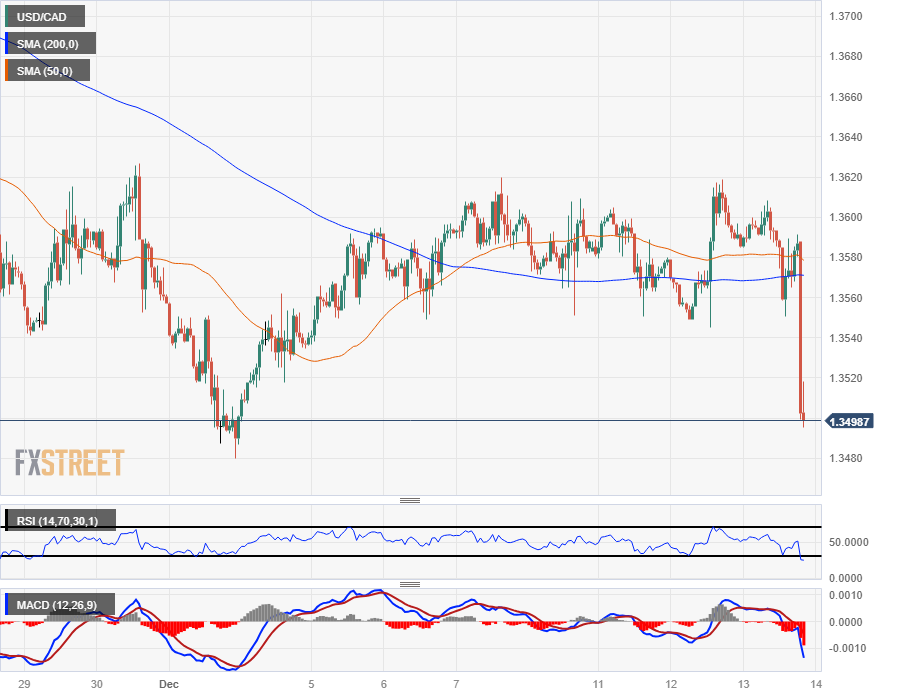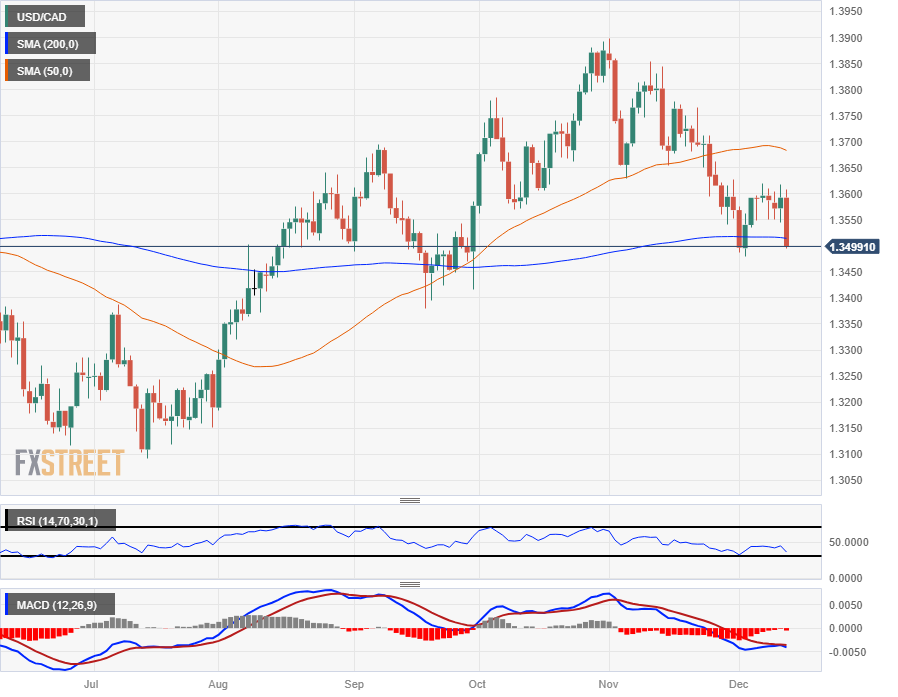Canadian Dollar jumps into new weekly highs as Fed sees rate cuts in 2024

- Canadian Dollar rides a risk-on wave after Fed cuts rate expectations.
- FOMC’s updated dot plot sees three cuts for 75 basis points in rate cuts in 2024.
- CAD catches a supporting bid from rising Crude Oil, WTI bounces from new lows.
The Canadian Dollar (CAD) is well-bid against ther US Dollar (USD) on Wednesday, gaining additional support from a thin but noticeable relief rally in Crude Oil markets. The Federal Reserve (Fed) slashed its Interest Rate Expectations for 2024, and Fed policymakers see at least three rate cuts in 2024, for a combined 75 basis points in cuts for next year’s interest rate.
The Canadian economic calendar remains tepid this week; Loonie traders will be forced to wait until Bank of Canada (BoC) Governor Tiff Macklem’s appearance late Friday before the CAD finds tradeable headlines from behind home plate.
With the Fed’s rate statement out of the way and the FOMC holding rates at 5.5% for the last meeting of the year, forecasting accelerated rate cuts looking forward, markets will be focusing on Fed Chairman Jerome Powell’s press conference, due 30 minutes after the Fed’s rate statement.
Daily Digest Market Movers: Canadian Dollar grinds through frothy markets ahead of Fed rate call
- Despite the Canadian Dollar’s Crude Oil-fueled bid on Wednesday, the Fed is stealing the limelight, and it’s all eyes on Powell for the mid-week market session.
- The Federal Reserve held rates at 5.5% for the third straight FOMC meeting, its longest holding pattern since the most recent rate hike cycle began in early 2022.
- Investors are broadly anticipating an accelerated path toward more frequent rate cuts next year.
- Markets are anticipating rate cuts to begin as soon as the first quarter of 2024, and investor expectations of easing rates may have run well ahead of what the Fed considers achievable.
- With Fed Chair Powell scrapping forward guidance last year, Fed rate statements have an outsized market impact as the US central bank assesses data on a case-by-case basis.
- Crude Oil markets sank to fresh lows this week, with West Texas Intermediate (WTI) sagging into $68 per barrel early Wednesday before catching a near-term relief rally back toward $70.
- The Canadian Dollar is latching onto the rebound in Crude Oil to squeeze out a gain against the US Dollar (USD), climbing six-tenths of a percent against the Greenback as markets see a broad risk bid.
Canadian Dollar price today
The table below shows the percentage change of Canadian Dollar (CAD) against listed major currencies today. Canadian Dollar was the strongest against the US Dollar.
| USD | EUR | GBP | CAD | AUD | JPY | NZD | CHF | |
| USD | -0.76% | -0.46% | -0.64% | -1.60% | -1.67% | -1.11% | -0.42% | |
| EUR | 0.77% | 0.31% | 0.15% | -0.83% | -0.89% | -0.34% | 0.35% | |
| GBP | 0.43% | -0.31% | -0.17% | -1.16% | -1.20% | -0.67% | 0.01% | |
| CAD | 0.62% | -0.13% | 0.17% | -0.98% | -1.04% | -0.49% | 0.19% | |
| AUD | 1.59% | 0.83% | 1.14% | 0.98% | -0.05% | 0.48% | 1.16% | |
| JPY | 1.62% | 0.89% | 1.16% | 0.98% | 0.03% | 0.53% | 1.22% | |
| NZD | 1.09% | 0.35% | 0.64% | 0.50% | -0.48% | -0.56% | 0.67% | |
| CHF | 0.42% | -0.33% | -0.02% | -0.18% | -1.17% | -1.22% | -0.68% |
The heat map shows percentage changes of major currencies against each other. The base currency is picked from the left column, while the quote currency is picked from the top row. For example, if you pick the Euro from the left column and move along the horizontal line to the Japanese Yen, the percentage change displayed in the box will represent EUR (base)/JPY (quote).
Technical Analysis: Canadian Dollar cracks through the bottom end of consolidation to retest 1.3500
The Canadian Dollar (CAD) saw choppy trading forming into a near-term sideways channel against the US Dollar (USD), keeping the USD/CAD capped between 1.3610 and 1.3550 before Wednesday’s blowout Fed showing sent the pair back into the 1.3500 handle. Intraday action has turned firmly bearish, sending the pair tumbling clean through the 200-hour Simple Moving Average (SMA) near 1.3570.
A bounce from the 200-day SMA for the USD/CAD at the start of December has failed to crystallize into a meaningful bullish recovery, keeping the pair constrained in a congestion zone just beneath the 1.3600 handle. The pair is now falling back into the 200-day SMA.
The US Dollar is down two-and-a-third percent against the Canadian Dollar after dropping from December’s early high of 1.3899 and making a clean shear of the 50-day SMA just below 1.3700.
Fundamentals are going to drive the USD/CAD on Wednesday, and technical traders will need to be mindful that technical barriers could easily evaporate, depending on how investors digest the day’s headlines.
USD/CAD Hourly Chart
USD/CAD Daily Chart

Fed FAQs
Monetary policy in the US is shaped by the Federal Reserve (Fed). The Fed has two mandates: to achieve price stability and foster full employment. Its primary tool to achieve these goals is by adjusting interest rates.
When prices are rising too quickly and inflation is above the Fed’s 2% target, it raises interest rates, increasing borrowing costs throughout the economy. This results in a stronger US Dollar (USD) as it makes the US a more attractive place for international investors to park their money.
When inflation falls below 2% or the Unemployment Rate is too high, the Fed may lower interest rates to encourage borrowing, which weighs on the Greenback.
The Federal Reserve (Fed) holds eight policy meetings a year, where the Federal Open Market Committee (FOMC) assesses economic conditions and makes monetary policy decisions.
The FOMC is attended by twelve Fed officials – the seven members of the Board of Governors, the president of the Federal Reserve Bank of New York, and four of the remaining eleven regional Reserve Bank presidents, who serve one-year terms on a rotating basis.
In extreme situations, the Federal Reserve may resort to a policy named Quantitative Easing (QE). QE is the process by which the Fed substantially increases the flow of credit in a stuck financial system.
It is a non-standard policy measure used during crises or when inflation is extremely low. It was the Fed’s weapon of choice during the Great Financial Crisis in 2008. It involves the Fed printing more Dollars and using them to buy high grade bonds from financial institutions. QE usually weakens the US Dollar.
Quantitative tightening (QT) is the reverse process of QE, whereby the Federal Reserve stops buying bonds from financial institutions and does not reinvest the principal from the bonds it holds maturing, to purchase new bonds. It is usually positive for the value of the US Dollar.
